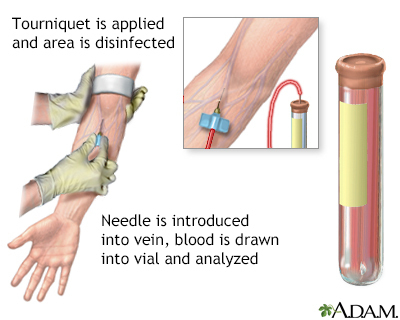Phosphorus blood test
Definition
The phosphorus blood test measures the amount of phosphate in the blood.
Alternative Names
Phosphorus - serum; HPO4-2; PO4-3; Inorganic phosphate; Serum phosphorus
How the Test is Performed
A blood sample is needed.
How to Prepare for the Test
Your health care provider may tell you to temporarily stop taking medicines that may affect the test. These medicines include water pills (diuretics), antacids, and laxatives.
Do not stop taking any medicine before talking to your provider.
How the Test will Feel
When the needle is inserted to draw blood, some people feel moderate pain. Others feel only a prick or stinging. Afterward, there may be some throbbing or slight bruising. This soon goes away.
Why the Test is Performed
Phosphorus is a mineral the body needs to build strong bones and teeth. It is also important for nerve signaling and muscle contraction.
This test is ordered to see how much phosphorus is in your blood. Kidney, liver, and certain bone diseases can cause abnormal phosphorus levels.
Normal Results
Normal values range from:
- Adults: 2.8 to 4.5 mg/dL
- Children: 4.0 to 7.0 mg/dL
Normal value ranges may vary slightly among different laboratories. Some labs use different measurements or test different samples. Talk to your provider about the meaning of your specific test results.
What Abnormal Results Mean
A higher than normal level (hyperphosphatemia) may be due to many different health conditions. Common causes include:
- Diabetic ketoacidosis (life-threatening condition that may occur mainly in people with type 1 diabetes)
- Hypoparathyroidism (parathyroid glands do not make enough of their hormone)
- Kidney damage or failure
- Liver disease
- Too much vitamin D
- Too much phosphate in your diet
- Use of certain medicines such as laxatives that have phosphate in them
A lower than normal level (hypophosphatemia) may be due to:
- Alcoholism
- Hypercalcemia (too much calcium in the blood)
- Primary hyperparathyroidism (parathyroid glands make too much of their hormone)
- Too little dietary intake of phosphate
- Very poor nutrition
- Too little vitamin D, resulting in bone problems such as rickets (childhood) or osteomalacia (adult)
Risks
There is little risk involved with having your blood taken. Veins and arteries vary in size from one person to another and from one side of the body to the other. Taking blood from some people may be more difficult than from others.
Other risks associated with having blood drawn are slight, but may include:
- Fainting or feeling lightheaded
- Multiple punctures to locate veins
- Hematoma (blood buildup under the skin)
- Excessive bleeding
- Infection (a slight risk any time the skin is broken)
Gallery

References
Chonchol M, Smogorzewski MJ, Stubbs JR, Yu ASL. Disorders of calcium, magnesium, and phosphate balance. In: Yu ASL, Chertow GM, Luyckx VA, Marsden PA, Skorecki K, Taal MW, eds. Brenner and Rector's The Kidney. 11th ed. Philadelphia, PA: Elsevier; 2020:chap 18.
Klemm KM, Klein MJ. Zhang Y. Biochemical markers of bone metabolism.In: McPherson RA, Pincus MR, eds. Henry's Clinical Diagnosis and Management by Laboratory Methods. 24th ed. Philadelphia, PA: Elsevier; 2022:chap 16.
Kliegman RM, Stanton BF, St. Geme JW, Blum NJ, Shah SS, Tasker RC, Wilson KM. Electrolyte and acid-base disorders. In: Kliegman RM, St. Geme JW, Blum NJ, Shah SS, Tasker RC, Wilson KM, eds. Nelson Textbook of Pediatrics. 21st ed. Philadelphia, PA: Elsevier; 2020:chap 68.